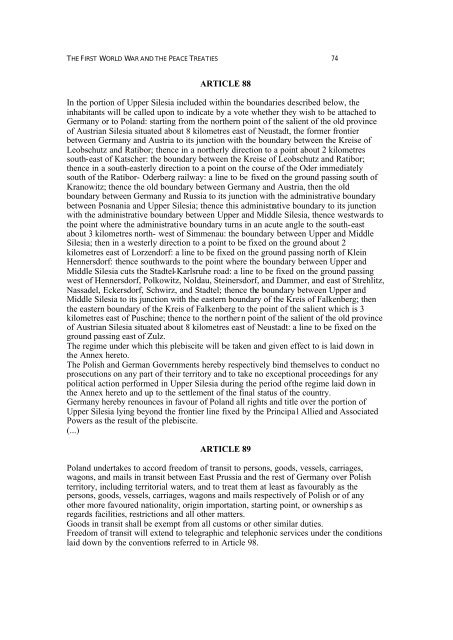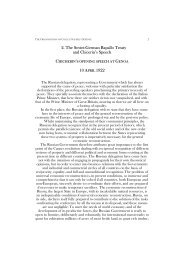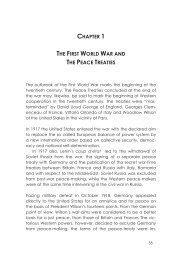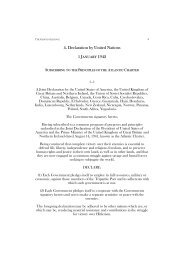Peace Treaty of Versailles - Fransamaltingvongeusau.com
Peace Treaty of Versailles - Fransamaltingvongeusau.com
Peace Treaty of Versailles - Fransamaltingvongeusau.com
Create successful ePaper yourself
Turn your PDF publications into a flip-book with our unique Google optimized e-Paper software.
THE FIRST WORLD WAR AND THE PEACE TREATIES 74<br />
ARTICLE 88<br />
In the portion <strong>of</strong> Upper Silesia included within the boundaries described below, the<br />
inhabitants will be called upon to indicate by a vote whether they wish to be attached to<br />
Germany or to Poland: starting from the northern point <strong>of</strong> the salient <strong>of</strong> the old province<br />
<strong>of</strong> Austrian Silesia situated about 8 kilometres east <strong>of</strong> Neustadt, the former frontier<br />
between Germany and Austria to its junction with the boundary between the Kreise <strong>of</strong><br />
Leobschutz and Ratibor; thence in a northerly direction to a point about 2 kilometres<br />
south-east <strong>of</strong> Katscher: the boundary between the Kreise <strong>of</strong> Leobschutz and Ratibor;<br />
thence in a south-easterly direction to a point on the course <strong>of</strong> the Oder immediately<br />
south <strong>of</strong> the Ratibor- Oderberg railway: a line to be fixed on the ground passing south <strong>of</strong><br />
Kranowitz; thence the old boundary between Germany and Austria, then the old<br />
boundary between Germany and Russia to its junction with the administrative boundary<br />
between Posnania and Upper Silesia; thence this administrative boundary to its junction<br />
with the administrative boundary between Upper and Middle Silesia, thence westwards to<br />
the point where the administrative boundary turns in an acute angle to the south-east<br />
about 3 kilometres north- west <strong>of</strong> Simmenau: the boundary between Upper and Middle<br />
Silesia; then in a westerly direction to a point to be fixed on the ground about 2<br />
kilometres east <strong>of</strong> Lorzendorf: a line to be fixed on the ground passing north <strong>of</strong> Klein<br />
Hennersdorf: thence southwards to the point where the boundary between Upper and<br />
Middle Silesia cuts the Stadtel-Karlsruhe road: a line to be fixed on the ground passing<br />
west <strong>of</strong> Hennersdorf, Polkowitz, Noldau, Steinersdorf, and Dammer, and east <strong>of</strong> Strehlitz,<br />
Nassadel, Eckersdorf, Schwirz, and Stadtel; thence the boundary between Upper and<br />
Middle Silesia to its junction with the eastern boundary <strong>of</strong> the Kreis <strong>of</strong> Falkenberg; then<br />
the eastern boundary <strong>of</strong> the Kreis <strong>of</strong> Falkenberg to the point <strong>of</strong> the salient which is 3<br />
kilometres east <strong>of</strong> Puschine; thence to the norther n point <strong>of</strong> the salient <strong>of</strong> the old province<br />
<strong>of</strong> Austrian Silesia situated about 8 kilometres east <strong>of</strong> Neustadt: a line to be fixed on the<br />
ground passing east <strong>of</strong> Zulz.<br />
The regime under which this plebiscite will be taken and given effect to is laid down in<br />
the Annex hereto.<br />
The Polish and German Governments hereby respectively bind themselves to conduct no<br />
prosecutions on any part <strong>of</strong> their territory and to take no exceptional proceedings for any<br />
political action performed in Upper Silesia during the period <strong>of</strong> the regime laid down in<br />
the Annex hereto and up to the settlement <strong>of</strong> the final status <strong>of</strong> the country.<br />
Germany hereby renounces in favour <strong>of</strong> Poland all rights and title over the portion <strong>of</strong><br />
Upper Silesia lying beyond the frontier line fixed by the Principa l Allied and Associated<br />
Powers as the result <strong>of</strong> the plebiscite.<br />
(...)<br />
ARTICLE 89<br />
Poland undertakes to accord freedom <strong>of</strong> transit to persons, goods, vessels, carriages,<br />
wagons, and mails in transit between East Prussia and the rest <strong>of</strong> Germany over Polish<br />
territory, including territorial waters, and to treat them at least as favourably as the<br />
persons, goods, vessels, carriages, wagons and mails respectively <strong>of</strong> Polish or <strong>of</strong> any<br />
other more favoured nationality, origin importation, starting point, or ownership s as<br />
regards facilities, restrictions and all other matters.<br />
Goods in transit shall be exempt from all customs or other similar duties.<br />
Freedom <strong>of</strong> transit will extend to telegraphic and telephonic services under the conditions<br />
laid down by the conventions referred to in Article 98.







